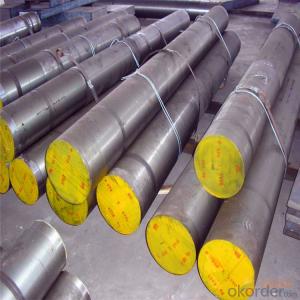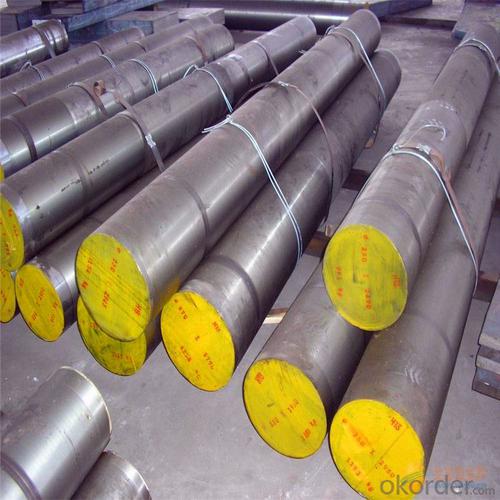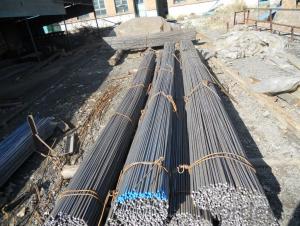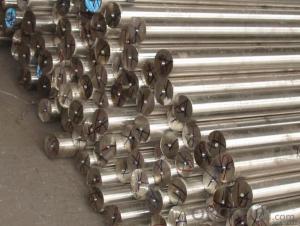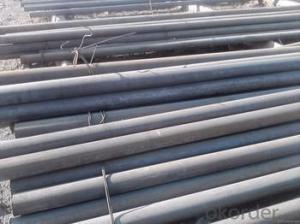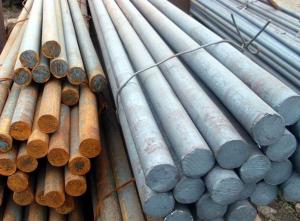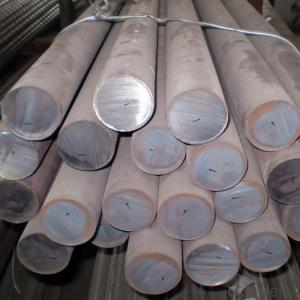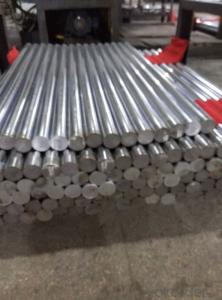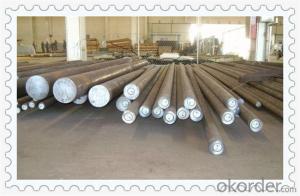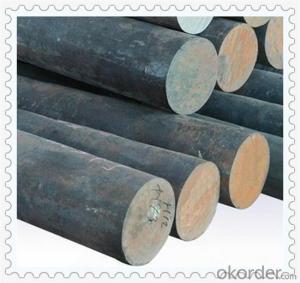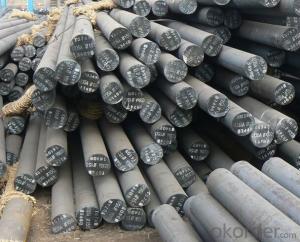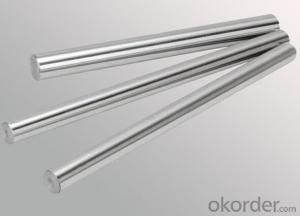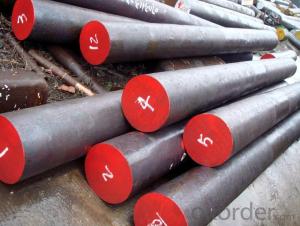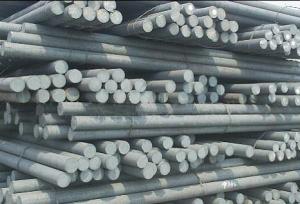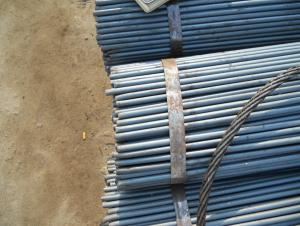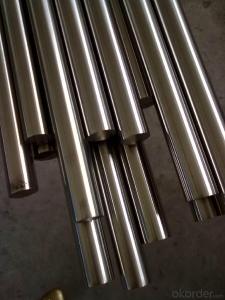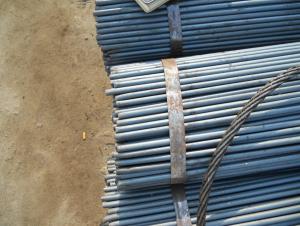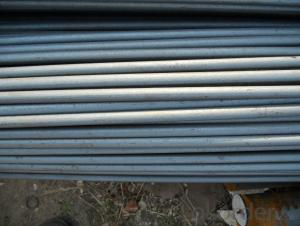Forged Alloy Steel 52100 Steel Round Bar
- Loading Port:
- Shanghai
- Payment Terms:
- TT OR LC
- Min Order Qty:
- 100 m.t.
- Supply Capability:
- 50000 m.t./month
OKorder Service Pledge
OKorder Financial Service
You Might Also Like
Specification
Forged Alloy Steel 52100 Steel Round Bar
Product Description of Forged Alloy Steel 52100 Steel Round Bar
1. Steel grade: ASTM52100, SUJ2, 100Gr6,GCr15
2. Length: 6M-12M
3. Diameter: 16mm-300mm
4. Product range: round bar, flat bar, square bar,wire rod, sheet
5. Technique: Hot rolled, forged, cold drawn
Specification of Forged Alloy Steel 52100 Steel Round Bar
Material | 52100 | Round bar | Dia(mm) | 10-300mm |
Process | EAF + LF + VD + Forged + Heat Treatment (optional) | Length (mm) | Max 12m | |
Heat treatment | Normalized / Annealed / Quenched / tempered | Flat bar | Thickness(mm) | 8-500mm |
Delivery condition | Hot forged +Rough machined (black surface after Q/T)+ Turned (optional) | Width(mm) | 70-200mm | |
Test | Ultrasonic test according to SEP 1921-84 D/d | Length (mm) | Max 12m |
Chemical Composition of Forged Alloy Steel 52100 Steel Round Bar
C | Si | Mn | Cr | Ni | Mo | P | S |
0.95~1.05 | 0.15~0.35 | 0.25~0.45 | 1.40~1.65 | ≤0.30 | ≤0.10 | ≤0.025 | ≤0.025 |
Photo Show of Forged Alloy Steel 52100 Steel Round Bar
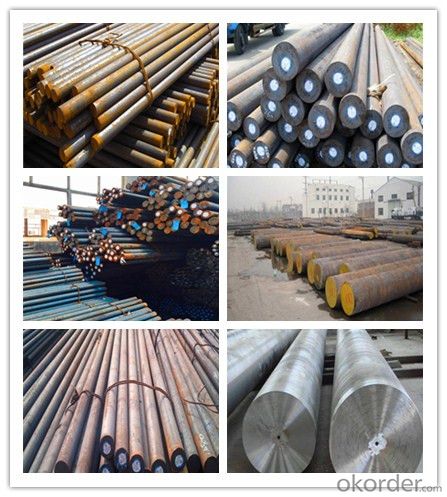
Packing and Delivery:
Packing in bundle package, or as customer's requirements.
Delivery Detail: 45 days after receiving the deposit.
Usage and Applications of Forged Alloy Steel 52100 Steel Round Bar
1. Steel round bar is used in a large number of architectural and engineering structures. Or it can be used in construction of plants for the production of steel house frames, high-voltage transmission towers, bridges, vehicles, boilers, containers, ships, etc.
2. And we can use this kind of product on the performance of the mechanical parts if the demand is not very high.
3. Some special material steel round bar can be used for main shaft of steamer, hummer shank, with big section and supper force.
Company Information
CNBM International Corporation is the most important trading platform of CNBM group.
Whith its advantages, CNBM International are mainly concentrate on Cement, Glass, Iron and Steel, Ceramics industries and devotes herself for supplying high qulity series of refractories as well as technical consultancies and logistics solutions.

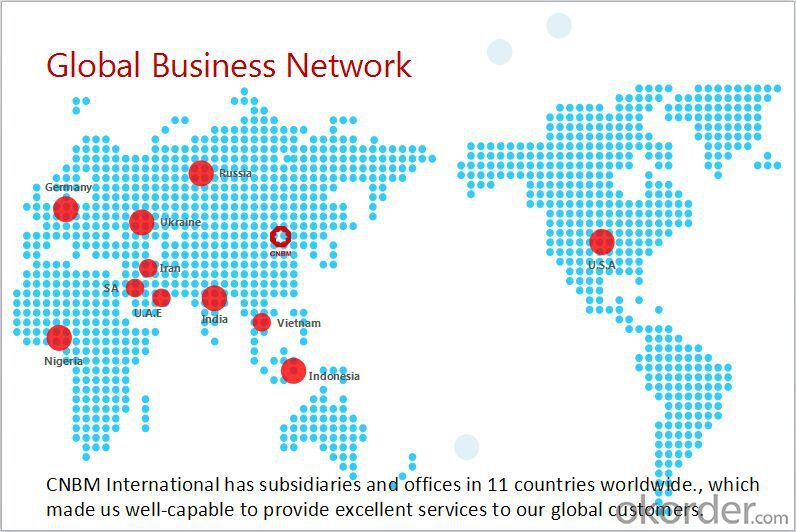
F A Q
1, Your advantages?
professional products inquiry, products knowledge train (for agents), smooth goods delivery, excellent customer solution proposale
2, Test & Certificate?
SGS test is available, customer inspection before shipping is welcome, third party inspection is no problem
3, Factory or Trading Company?
CNBM is a trading company but we have so many protocol factories and CNBM works as a trading department of these factories. Also CNBM is the holding company of many factories.
4, Payment Terms?
30% TT as deposit and 70% before delivery.
Irrevocable L/C at sight.
5, Trading Terms?
EXW, FOB, CIF, FFR, CNF
6, After-sale Service?
CNBM provides the services and support you need for every step of our cooperation. We're the business partner you can trust.
For any problem, please kindly contact us at any your convenient time.
We'll reply you in our first priority within 24 hours.
- Q: What is the difference between a polished and a hot rolled steel round bar?
- The main difference between a polished and a hot rolled steel round bar lies in their manufacturing processes and the resulting surface finish. Hot rolled steel round bars are produced by heating a steel billet or ingot to high temperatures and then rolling it into the desired shape, typically a round bar. This process results in a rough and uneven surface finish with mill scale and imperfections. The hot rolled bars are generally used for applications where surface finish is not critical, such as structural components, machinery parts, and construction materials. On the other hand, polished steel round bars undergo additional processing to achieve a smooth and shiny surface finish. After the hot rolling process, the bars are processed through various grinding and polishing techniques to remove the mill scale, surface imperfections, and achieve a uniform finish. This results in a refined and aesthetically pleasing surface that is suitable for applications where appearance and visual appeal matter, such as decorative items, furniture, and architectural components. In addition to the surface finish, the mechanical properties of the two types of steel round bars can also differ. The hot rolled bars generally have a rougher surface and may exhibit some residual stresses, while the polished bars have a smoother surface and reduced internal stresses. However, the overall mechanical properties, such as strength and hardness, are primarily determined by the grade and composition of the steel used, rather than the manufacturing process or surface finish. In summary, the difference between a polished and a hot rolled steel round bar lies in their surface finish. Hot rolled bars have a rough and uneven surface with mill scale and imperfections, while polished bars undergo additional processing to achieve a smooth and shiny finish. The choice between the two depends on the specific application and the desired appearance of the final product.
- Q: Can steel round bars be used for making sway bars?
- Certainly! Sway bars can indeed be crafted using steel round bars. These bars, also recognized as stabilizer bars or anti-roll bars, are implemented in automobiles to diminish body roll and enhance stability while maneuvering corners. The utilization of steel round bars is quite prevalent for this task owing to their remarkable robustness and endurance. The circular form facilitates the uniform dispersion of forces and furnishes crucial torsional stiffness necessary for sway bars to effectively govern body roll. Furthermore, steel is effortlessly obtainable, economical, and can be conveniently shaped and sized to cater to sway bar requirements.
- Q: What are the different surface hardness options for steel round bars?
- Steel round bars can have varying levels of surface hardness depending on the specific requirements and applications. Some of the different surface hardness options for steel round bars include: 1. Soft or annealed: This is the lowest level of surface hardness, where the steel is heated and then slowly cooled to reduce internal stress and increase ductility. Soft or annealed steel is easier to machine and form but has lower strength and wear resistance. 2. Normalized: Normalizing involves heating the steel to a specified temperature and then cooling it in air. This process refines the grain structure and improves the mechanical properties of the steel, resulting in increased hardness compared to annealed steel. 3. Quenched and tempered: This is a heat treatment process that involves heating the steel to a high temperature and then rapidly cooling it in a quenching medium like oil or water. The rapid cooling hardens the surface of the steel, while the subsequent tempering process reduces internal stresses and increases toughness. Quenched and tempered steel round bars have high hardness and strength, making them suitable for applications that require resistance to wear and impact. 4. Induction hardened: Induction hardening is a surface hardening process that involves heating only the surface of the steel round bar using an induction coil. This localized heating is followed by rapid quenching, resulting in a hardened surface layer with increased wear resistance. The core of the steel remains unaffected, retaining its toughness. 5. Case hardened: Case hardening, also known as carburizing, involves introducing carbon into the surface layer of the steel round bar. This is typically done by exposing the steel to a carbon-rich gas or by heating it with a carbon-containing material. The carbon diffuses into the surface and increases the hardness, while the core remains relatively softer. Case hardened steel round bars have a tough core with a wear-resistant surface. These are just a few of the different surface hardness options available for steel round bars. The choice of hardness will depend on the specific application requirements, such as strength, wear resistance, and toughness needed for the intended use.
- Q: How to distinguish between cold plating and hot rolled round steel?
- Cold galvanizing also called electro galvanized, is the use of the workpiece after electrolysis equipment except oil, after pickling solution into the composition of the zinc salt in the anode and connected electrolytic equipment; cathode zinc plate placed in the workpiece in the electrolysis equipment connected across the power supply is switched on, the current directional moves from the anode to the negative pole, will depositing a layer of zinc on the workpiece.
- Q: What is the difference between a turned and a polished steel round bar?
- A turned steel round bar and a polished steel round bar both undergo separate processes that result in different surface finishes and properties. A turned steel round bar is typically created by using a lathe machine to remove material from the surface of a steel bar. This process involves rotating the bar against a cutting tool, which cuts away the outer layer and leaves behind a smooth and cylindrical surface. The turned bar may have visible machining marks due to the cutting process, although it is generally considered to have a more precise and uniform diameter compared to other types of steel bars. Turned bars are often used in applications where dimensional accuracy is crucial, such as in machinery or tooling. On the other hand, a polished steel round bar undergoes a different process that involves grinding or buffing the surface to achieve a smooth and reflective finish. Polishing removes any imperfections or roughness from the surface of the steel bar, resulting in a highly lustrous appearance. Polished bars are often used in decorative applications or where visual aesthetics are important, such as in architectural designs or high-end consumer products. In summary, the main difference between a turned and a polished steel round bar lies in their respective manufacturing processes and resulting surface finishes. A turned bar is machined to achieve precise dimensions, while a polished bar is subjected to a polishing process to obtain a smooth and reflective surface. The choice between the two depends on the specific requirements of the application, with turned bars being preferred for dimensional accuracy and polished bars for aesthetic appeal.
- Q: Are steel round bars suitable for construction applications?
- Yes, steel round bars are suitable for construction applications. Steel round bars are widely used in the construction industry due to their strength, durability, and versatility. They offer excellent structural support and are commonly used in the construction of buildings, bridges, and infrastructure projects. Steel round bars can withstand heavy loads and provide stability to structures, making them suitable for various construction applications. Additionally, steel round bars can be easily fabricated, cut, and welded to meet specific project requirements. Their corrosion resistance properties also make them suitable for both indoor and outdoor construction applications. Overall, steel round bars are an ideal choice for construction projects due to their strength, durability, versatility, and ease of use.
- Q: Can steel round bars be used for making security grilles?
- Yes, steel round bars can be used for making security grilles. Steel is a durable and strong material that provides excellent security for windows and doors. Round bars can be welded together to create a sturdy framework for the security grilles. Additionally, steel round bars can be easily customized and shaped to fit any size or design requirement, making them suitable for various types of security grilles. The hardness and toughness of steel also make it resistant to cutting or tampering, further enhancing the security features of the grilles. Overall, steel round bars are a reliable choice for making security grilles due to their strength, durability, and customization capabilities.
- Q: Can steel round bars be used in the pharmaceutical industry?
- Yes, steel round bars can be used in the pharmaceutical industry. Steel round bars are commonly used in various industries, including pharmaceuticals, due to their strength, durability, and versatility. In the pharmaceutical industry, steel round bars can be utilized for a range of applications such as manufacturing equipment, machinery, and storage systems. These bars can be used to construct pharmaceutical manufacturing equipment like mixers, reactors, and centrifuges, which require robust and reliable materials to ensure efficiency and safety in pharmaceutical production processes. Additionally, steel round bars can be employed in the construction of storage systems such as racks and shelves, providing a sturdy and secure solution for organizing pharmaceutical products and supplies. The corrosion resistance and ease of cleaning of steel make it suitable for maintaining hygienic conditions in pharmaceutical facilities. Overall, steel round bars offer the pharmaceutical industry a reliable and cost-effective material option for various applications.
- Q: Can steel round bars be used in automotive applications?
- Yes, steel round bars can be used in automotive applications. Steel round bars are commonly used in various automotive components and systems due to their strength, durability, and versatility. They can be used in the manufacturing of engine parts, suspension components, drive shafts, axles, and other structural parts of vehicles. Steel round bars offer excellent mechanical properties, including high tensile strength and good resistance to impact and fatigue, making them suitable for withstanding the demanding conditions experienced in automotive applications. Additionally, steel round bars can be easily machined, welded, and formed into the desired shape, allowing for efficient manufacturing processes in the automotive industry.
- Q: What are the limitations of using steel round bars?
- Using steel round bars in various applications has several limitations. One such limitation is their vulnerability to corrosion. Steel round bars, particularly those made of carbon steel, are prone to rusting when exposed to moisture or harsh environments. This can have a significant impact on their structural integrity and lifespan. Another limitation is their weight. Steel is a heavy material, and round bars can be especially cumbersome to handle and transport, especially in large quantities. This can make the installation process more difficult and increase the overall project cost. In addition, steel round bars may not be suitable for applications that require high levels of flexibility or bending. Their rigid nature makes it challenging to shape or mold them into intricate designs. This limitation can restrict their use in certain industries or architectural designs that demand more versatile materials. Another factor to consider is the cost of steel round bars. Depending on the grade, quality, and market conditions, the price of steel round bars can fluctuate significantly. This can be a financial limitation for projects with tight budgets or when the cost of raw materials is a crucial factor. Lastly, steel round bars may not be suitable for applications that require high resistance to extreme temperatures. While steel has good thermal conductivity, certain temperature ranges can affect its structural properties, potentially causing weaknesses or deformations. Overall, steel round bars have widespread use and offer many advantages. However, it is essential to consider their limitations such as susceptibility to corrosion, weight, limited flexibility, cost, and temperature sensitivity when selecting materials for specific applications.
Send your message to us
Forged Alloy Steel 52100 Steel Round Bar
- Loading Port:
- Shanghai
- Payment Terms:
- TT OR LC
- Min Order Qty:
- 100 m.t.
- Supply Capability:
- 50000 m.t./month
OKorder Service Pledge
OKorder Financial Service
Similar products
Hot products
Hot Searches
Related keywords
